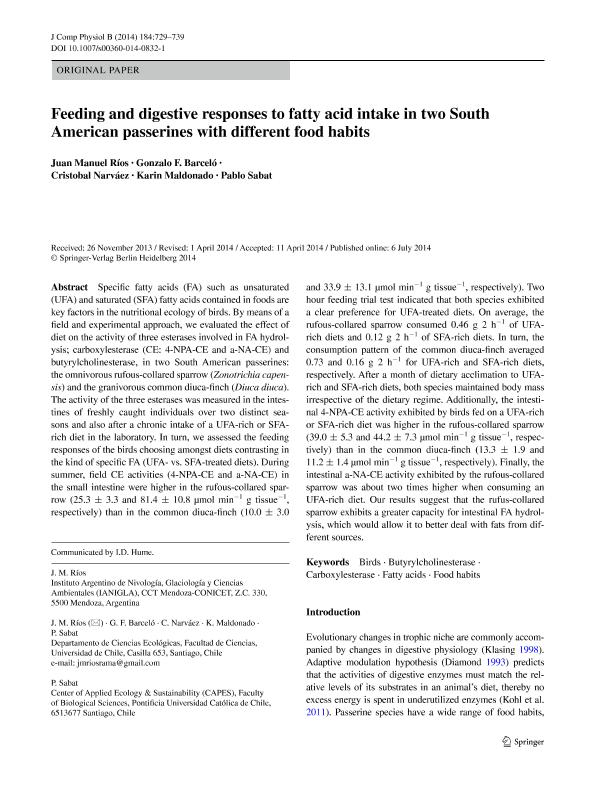Mostrar el registro sencillo del ítem
dc.contributor.author
Rios, Juan Manuel

dc.contributor.author
Barceló, Gonzalo F.
dc.contributor.author
Narváez, Cristobal
dc.contributor.author
Maldonado, Karin
dc.contributor.author
Sabat, Pablo
dc.date.available
2018-01-02T18:44:59Z
dc.date.issued
2014-07
dc.identifier.citation
Sabat, Pablo; Maldonado, Karin; Narváez, Cristobal; Barceló, Gonzalo F.; Rios, Juan Manuel; Feeding and digestive responses to fatty acid intake in two South American passerines with different food habits; Springer Heidelberg; Journal of Comparative Physiology B: Biochemical, Systems and Environmental Physiology; 184; 6; 7-2014; 729-739
dc.identifier.issn
0174-1578
dc.identifier.uri
http://hdl.handle.net/11336/32013
dc.description.abstract
Specific fatty acids (FA) such as unsaturated (UFA) and saturated (SFA) fatty acids contained in foods are key factors in the nutritional ecology of birds. By means of a field and experimental approach, we evaluated the effect of diet on the activity of three esterases involved in FA hydrolysis; carboxylesterase (CE: 4-NPA-CE and a-NA-CE) and butyrylcholinesterase, in two South American passerines: the omnivorous rufous-collared sparrow (Zonotrichia capensis) and the granivorous common diuca-finch (Diuca diuca). The activity of the three esterases was measured in the intestines of freshly caught individuals over two distinct seasons and also after a chronic intake of a UFA-rich or SFA-rich diet in the laboratory. In turn, we assessed the feeding responses of the birds choosing amongst diets contrasting in the kind of specific FA (UFA- vs. SFA-treated diets). During summer, field CE activities (4-NPA-CE and a-NA-CE) in the small intestine were higher in the rufous-collared sparrow (25.3 ± 3.3 and 81.4 ± 10.8 µmol min−1 g tissue−1, respectively) than in the common diuca-finch (10.0 ± 3.0 and 33.9 ± 13.1 µmol min−1 g tissue−1, respectively). Two hour feeding trial test indicated that both species exhibited a clear preference for UFA-treated diets. On average, the rufous-collared sparrow consumed 0.46 g 2 h−1 of UFA-rich diets and 0.12 g 2 h−1 of SFA-rich diets. In turn, the consumption pattern of the common diuca-finch averaged 0.73 and 0.16 g 2 h−1 for UFA-rich and SFA-rich diets, respectively. After a month of dietary acclimation to UFA-rich and SFA-rich diets, both species maintained body mass irrespective of the dietary regime. Additionally, the intestinal 4-NPA-CE activity exhibited by birds fed on a UFA-rich or SFA-rich diet was higher in the rufous-collared sparrow (39.0 ± 5.3 and 44.2 ± 7.3 µmol min−1 g tissue−1, respectively) than in the common diuca-finch (13.3 ± 1.9 and 11.2 ± 1.4 µmol min−1 g tissue−1, respectively). Finally, the intestinal a-NA-CE activity exhibited by the rufous-collared sparrow was about two times higher when consuming an UFA-rich diet. Our results suggest that the rufus-collared sparrow exhibits a greater capacity for intestinal FA hydrolysis, which would allow it to better deal with fats from different sources.
dc.format
application/pdf
dc.language.iso
eng
dc.publisher
Springer Heidelberg

dc.rights
info:eu-repo/semantics/openAccess
dc.rights.uri
https://creativecommons.org/licenses/by-nc-sa/2.5/ar/
dc.subject
Birds
dc.subject
Butyrylcholinesterase
dc.subject
Carboxylesterase
dc.subject
Fatty Acids
dc.subject
Food Habits
dc.subject.classification
Meteorología y Ciencias Atmosféricas

dc.subject.classification
Ciencias de la Tierra y relacionadas con el Medio Ambiente

dc.subject.classification
CIENCIAS NATURALES Y EXACTAS

dc.subject.classification
Otras Ciencias Biológicas

dc.subject.classification
Ciencias Biológicas

dc.subject.classification
CIENCIAS NATURALES Y EXACTAS

dc.title
Feeding and digestive responses to fatty acid intake in two South American passerines with different food habits
dc.type
info:eu-repo/semantics/article
dc.type
info:ar-repo/semantics/artículo
dc.type
info:eu-repo/semantics/publishedVersion
dc.date.updated
2017-12-29T14:15:07Z
dc.identifier.eissn
1432-136X
dc.journal.volume
184
dc.journal.number
6
dc.journal.pagination
729-739
dc.journal.pais
Alemania

dc.journal.ciudad
Heidelberg
dc.description.fil
Fil: Rios, Juan Manuel. Consejo Nacional de Investigaciones Científicas y Técnicas. Centro Científico Tecnológico Conicet - Mendoza. Instituto Argentino de Nivología, Glaciología y Ciencias Ambientales. Provincia de Mendoza. Instituto Argentino de Nivología, Glaciología y Ciencias Ambientales. Universidad Nacional de Cuyo. Instituto Argentino de Nivología, Glaciología y Ciencias Ambientales; Argentina. Universidad de Chile; Chile
dc.description.fil
Fil: Barceló, Gonzalo F.. Universidad de Chile; Chile
dc.description.fil
Fil: Narváez, Cristobal. Universidad de Chile; Chile
dc.description.fil
Fil: Maldonado, Karin. Universidad de Chile; Chile
dc.description.fil
Fil: Sabat, Pablo. Universidad de Chile; Chile. Pontificia Universidad Católica de Chile; Chile
dc.journal.title
Journal of Comparative Physiology B: Biochemical, Systems and Environmental Physiology

dc.relation.alternativeid
info:eu-repo/semantics/altIdentifier/doi/http://dx.doi.org/10.1007/s00360-014-0832-1
dc.relation.alternativeid
info:eu-repo/semantics/altIdentifier/url/https://link.springer.com/article/10.1007%2Fs00360-014-0832-1
Archivos asociados
